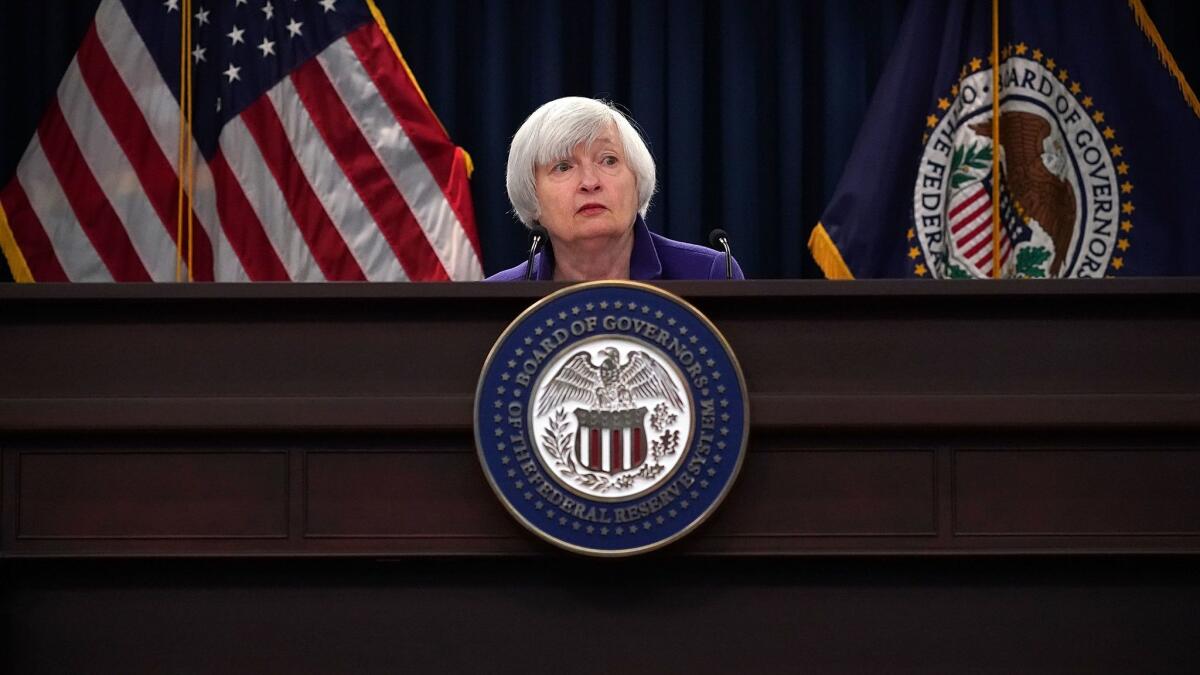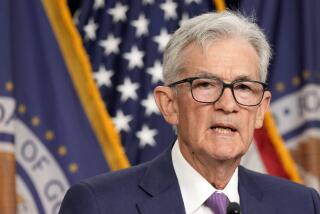Yellen’s legacy as Fed chief: Full employment but unfinished business

- Share via
Reporting from Washington — Even during her final news conference as chairwoman of the Federal Reserve, Janet L. Yellen last month stuck to the careful approach that helped her guide the central bank through a pivotal period.
Asked if she was disappointed that her historic tenure as the first woman to lead the Fed was ending after just one term, she demurred. She brushed off a query about whether the Republican tax cuts were ill-timed. She wouldn’t even bite on a lighthearted question about which black dot was hers on the quarterly chart of Fed policymakers’ interest rate forecasts.
“I’ve never been willing to reveal which dot is mine,” she said, smiling, “and I’m not going to change that now.”
When Yellen steps down next month, she’ll depart with the economy in strong shape and monetary policymakers armed with more options than they’ve had in years, should it falter.
But the soft-spoken former UC Berkeley economist also leaves some important unfinished business after an unusually short four-year stint as leader of the world’s most influential central bank.
While the nation has essentially returned to full employment under her watch, inflation remains stubbornly below the Fed’s annual 2% target. That’s helped prevent faster wage growth and caused policymakers to fret about the longer-term consequences for the economy.
Also, although Yellen shepherded the effort to begin unwinding the extraordinary and controversial steps the Fed took to fight the financial crisis and Great Recession a decade ago, she won’t be around to complete the complicated task. And she won’t be presiding over the institution as it begins weighing potentially far-reaching changes in how it handles monetary policy in an era of slower growth.
Despite widespread praise for her performance, President Trump decided last fall not to renominate Yellen, a Democrat, for a second four-year term as chairwoman. Instead, he chose Fed governor Jerome H. Powell, a Republican who has been a loyal supporter of Yellen’s agenda.
The decision broke with the recent precedent of presidents extending the terms of Fed chiefs originally nominated by predecessors from the other political party. For Yellen, 71, that means she’ll have had the shortest tenure for a Fed leader in nearly four decades.
“She wanted to continue,” said Princeton economist Alan Blinder, a former Fed vice chairman and good friend of Yellen’s. “I think she always knew it was an uphill battle once Donald Trump got elected.”
With her term ending Feb. 3 -- three days after leading her last monetary policy meeting in which no new action is expected — Yellen won’t have the chance to leave the kind of mark left by her recent predecessors.
Paul Volcker is known for taming high inflation in the 1980s. Alan Greenspan oversaw the longest U.S. economic expansion on record while chairman for almost two decades, although the Fed under him also was blamed for the housing bubble that burst into the Great Recession. Ben S. Bernanke engineered the Fed’s aggressive response to the financial crisis and is credited with saving the nation from a second Depression.
“On the one hand, she didn’t have to deal with anything as difficult as Ben Bernanke did, not even close,” Blinder said. “But on the other hand, she handled the situation she got superbly.”
Said Donald Kohn, a senior fellow at the Brookings Institution think tank who was Fed vice chairman from 2006 to 2010: “She’s been able to lead the committee in a way that’s avoided major financial disruption while beginning the rollback of unconventional monetary policy. I think that’s quite an accomplishment.”
By all accounts, Yellen is wrapping up a distinguished career at the Fed.
She had a 2½-year stint as a Fed governor in the 1990s, then returned to Washington in 2010 to be Bernanke’s vice chairwoman before succeeding him. In between, Yellen taught at Berkeley’s Haas School of Business, chaired the White House Council of Economic Advisers under President Clinton, and served as president of the Federal Reserve Bank of San Francisco from 2004 to 2010, where she was involved in the Fed’s response to the financial crisis.
“I feel very positive about what we’ve been able to accomplish and feel tremendous...loyalty to the institution,” Yellen said in December at her last news conference as Fed chief.
She plans to continue living in the Washington area, where her husband, Nobel-prize winning economist George Akerlof, is a professor at Georgetown University. Like Bernanke, she’s likely to join a think tank, and could also write a book. The couple also will keep their home in Berkeley, she said.
When Yellen replaced Bernanke in early 2014, the economy was nearly five years into a recovery. But growth remained slow and the Fed’s monetary policy was still very much focused on stimulating growth. Bernanke had pushed the central bank to drop its key short-term interest rate to near zero and purchased trillions of dollars of government bonds to lower long-term rates.
It fell to Yellen to determine when the economy was strong enough to begin inching up the interest rate and start reducing the bonds on the Fed’s balance sheet.
Despite critics warning that the Fed’s policies to keep interest rates low would stoke asset bubbles and inflation, Yellen took a cautious and data-driven approach to withdrawing the stimulus. With Fed policymakers expecting continued low inflation, Yellen put greater weight on the second part of the Fed’s dual mandate — maximizing employment. She viewed the unemployment rate as understating the hardships in the labor market, even though the rate had dropped to 5% by fall 2015.
Her efforts to focus on the difficulties of Americans in finding work was part of the reason liberal Democrats had urged President Obama to nominate her to succeed Bernanke instead of the other leading candidate, Lawrence H. Summers, the former Treasury secretary who had been Obama’s top economic advisor. As chairwoman, Yellen made a point of visiting job training centers around the country and meeting with blue-collar workers to get a better sense of how Fed’s policies were playing out for average people.
“She wasn’t an ivory-tower Fed chair even though she had all the credentials to be one,” said Diane Swonk, chief economist at accounting and advisory firm Grant Thornton. “She brought that humanity of talking about individuals.”
During the 2016 presidential campaign, Trump pointedly accused Yellen of politicizing the traditionally apolitical institution by keeping interest rates artificially low to help fellow Democrats President Obama and Hillary Clinton. Most analysts rejected those criticisms and Trump appeared to change his views after he became president. When announcing his choice to go with Powell, Trump said he respected Yellen and that he thought “she’s done a good job.”
Though Yellen’s tenure was calm, it wasn’t without bumps. Yellen came in as an articulate central banker — she had crafted the Fed’s more-open communications policy for Bernanke — but in her first news conference in March 2014, she inadvertently suggested that the first interest rate hike since 2006 was coming sooner than expected. Her comment rattled financial markets.
When the Fed finally began increasing its key interest rate in December 2015, it went off without a hitch, as have successive rate hikes since then. It was the same when Fed policymakers announced in September that they would begin gradually reducing the central bank’s $4.5-trillion balance sheet, as Yellen had meticulously prepared financial markets with a clear timetable and road map for the reduction.
The Fed’s benchmark short-term interest rate now is between 1.25% and 1.5% — still low by historical standards. But Fed policymakers once again have the ability to lower the rate to stimulate growth if the economy slows.
“An underappreciated aspect of the Yellen Fed is how smoothly the transition from extraordinary monetary stimulus to policy normalization has proceeded,” said John Williams, president of the Federal Reserve Bank of San Francisco, in an email response to questions about her tenure. “This was not a foregone conclusion and it’s a testament to her leadership and preparation.”
And she did so not with a domineering style -- as some feared Summers would bring -- but by forging consensus among as many as 17 Fed officials over the years, most of them fiercely independent and who often publicly express their own views. Under Yellen’s tenure, there were on average 0.71 dissents per meeting of the policymaking Federal Open Market Committee, fewer than Bernanke had, according to data from the Federal Reserve Bank of St. Louis.
“She makes sure that everyone has multiple opportunities to add their perspectives and concerns and feels comfortable that we have thought through all the issues and contingencies,“ Williams said.
By the measuring stick of the labor market, Yellen has been one of the most successful Fed chairs. She leaves with the unemployment rate at 4.1%, the lowest since 2000.
“She got us back to full employment in a very graceful way,” said Mark Zandi, chief economist at Moody’s Analytics, referring to a state in which nearly everyone able and willing to work has a job.
Had Yellen been given a second term, Zandi thinks she would have let unemployment fall lower than what economists consider its optimal level to help even more disadvantaged workers. He said she probably would have further pursued another area that previous Fed leaders rarely spoke about — issues related to the nation’s wealth distribution. “She clearly was focused on it, and wanted to do something about it,” Zandi said. “But her time was cut short.”
Yellen also won’t be able to cross off perhaps the biggest item on her “undone list” — boosting persistently low inflation.
Though high inflation can hurt consumers by driving up prices, unusually low inflation can keep wages flat and hurt corporate profits.
Yellen has said temporary factors have been holding down inflation recently, like drops in prices of cellphone plans and prescription drugs. But after more than six years of falling short of the Fed’s inflation target, Yellen also has acknowledged that something else could be going on that is ingrained and even permanent. “There’s work undone there, in the sense we need to see it move up in line with our objective,” she said in December.
Yellen and most of her Fed colleagues believe inflation will soon rise faster as the low unemployment rate makes it increasingly harder for businesses to hire or replace workers, driving them to boost wages more sharply, which in turn would create inflationary pressures. But so far, that’s not happened on a wide scale. And there are forces that could be suppressing wages and economic activity more broadly, such as the slower-growing population and weak gains in worker productivity.
That has prompted experts, as well as some Fed officials, including Williams, to argue that this would be a good time for the central bank to rethink how it approaches monetary policy, something that policymakers will have to do without Yellen’s long experience and expertise in economics.
Chris Rupkey, chief financial economist at MUFG Union Bank in New York, said Yellen may be remembered mostly for her short tenure.
“It ended abruptly,’’ he said. “She didn’t get a chance to make a difference in terms of putting policies and procedures in place.”
Twitter: @JimPuzzanghera
More to Read
Inside the business of entertainment
The Wide Shot brings you news, analysis and insights on everything from streaming wars to production — and what it all means for the future.
You may occasionally receive promotional content from the Los Angeles Times.












